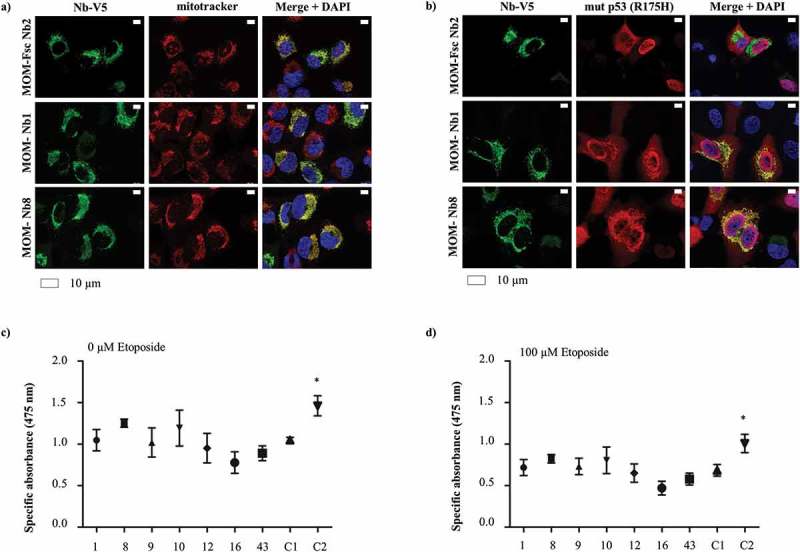Figure 5.

Nanobody-induced mitochondrial delocalization of HA-tagged mutant p53 (R175H) has no impact on cell viability of H1299 cells. H1299 (p53 null) cancer cells transiently express MOM/V5-tagged p53 TAD Nbs and HA-tagged mutant p53 (R175H). The MOM/V5-tagged Fsc Nb2 was used as negative control. (a) Representative epifluorescence images demonstrating the enrichment of MOM/V5-tagged Nbs at the mitochondria, which were labeled via Mitotracker. (b) HA-tagged mutant p53 (R175H) is largely distributed in a mitochondrial-like pattern in the presence of MOM/V5-tagged p53 TAD Nb1 and MOM/V5-tagged p53 TAD Nb8. Similar pattern cannot be observed in the presence of MOM/V5-tagged Fsc Nb2, where p53 displays a more uniform distribution. Visualization of the nuclei was achieved with DAPI, whilst HA-tagged mutant p53 (R175H) and the MOM/V5-tagged Nbs were visualized with an anti-HA antibody and an anti-V5 antibody, respectively. An XTT cell viability assay was performed to evaluate whether mitochondrial delocalization of HA-tagged mutant p53 (R175H) impacts cell viability. The assay was performed in the absence (c) or presence of 100 µM etoposide (d). Two negative controls were implemented, for which cells were either transiently transfected with the MOM/V5-tagged Fsc Nb2 (C1) or were subjected to a mock-transfection (C2). The HA-tagged mutant p53 (R175H) construct was expressed throughout all conditions. The graph represents the mean net absorbance of the formazan dye at 475 nm. None of the MOM/V5-tagged p53 TAD Nbs significantly alters H1299 cell viability compared to MOM/V5-tagged Fsc Nb2. Mock-transfected cells however display a significantly higher cellular proliferation and cell viability than MOM/V5-tagged Fsc Nb2-expressing cells (P < 0.05, one-way ANOVA, Dunnett’s multiple comparison test) (c). Similar results are obtained when cells receive the additional treatment with 100 µM etoposide (d), but globally there is a significant decrease in cell viability (P < 0.0001, two-way ANOVA), which occurs independently from possible effects exerted by the Nbs (P = 0.69, Two-way ANOVA) ((c) and (d)).
